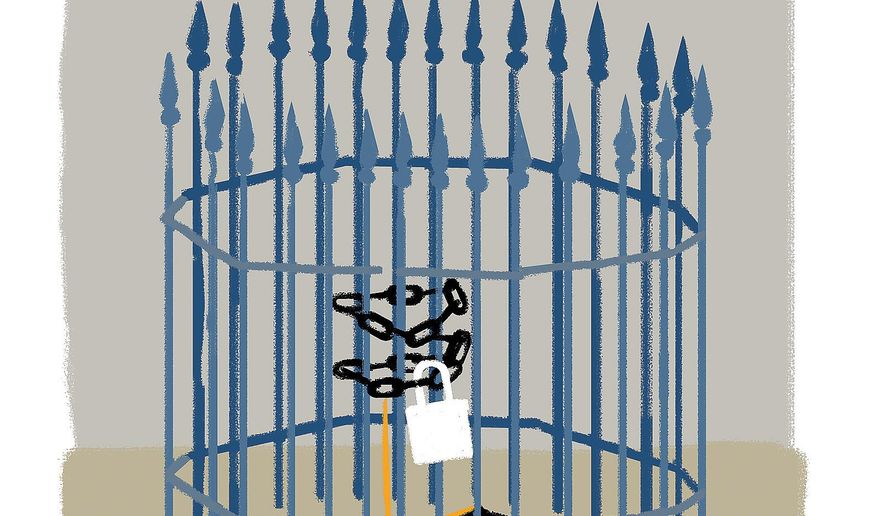OPINION:
Soon after taking office, President Trump ordered his national security advisers to provide “a complete strategic review of our policy toward the rogue regime in Iran.” Last month, based on that review, he announced a new strategy “to confront the Iranian regime’s hostile actions,” including its development of missiles capable of carrying nuclear warheads, its support for terrorists, and its neo-imperialist aggressions. This month that strategy is facing its first serious test.
Ironically, it’s the success of Mr. Trump’s policy of expeditiously defeating the Islamic State that has brought matters to a head so soon. The territories being liberated from the Islamic State are coveted by the Islamic Republic of Iran. You don’t have to be Carl von Clausewitz to grasp the consequences should those territories be surrendered to that regime.
Iran’s rulers are global revolutionaries and jihadis — that’s how they describe themselves. Their immediate goal is to establish what Jordan’s King Abdullah II has called a “Shia Crescent” in the Middle East.
They intend to become so powerful — and so dangerous — that no Iraqi government will dare defy them. Bashar Assad, the mass-murdering dictator they’ve rescued, is to serve as their obedient Syrian satrap. Hezbollah, their terrorist foreign legion, has been tightening its grip on Lebanon. Yemen’s Houthi rebels depend on Tehran for funding, arms and, presumably, instruction.
What the theocrats in Tehran plan to do next is no mystery. They will increasingly threaten the pro-American nations of the region: Saudi Arabia, Jordan, Bahrain, the United Arab Emirates and Israel among them.
And then there’s the question of nuclear weapons. Are Iranian scientists working on that capability now? We don’t know because Iran’s military facilities are not open to international inspectors — yet you don’t have to be Gen. George S. Patton to suspect that military facilities might be a convenient place to develop military weapons.
In any case, under the Joint Comprehensive Plan of Action (JCPOA), the deal concluded by President Obama without congressional approval, Iran also has a “patient pathway” to an industrial nuclear weapons capacity. The JCPOA’s restrictions on Iran begin to “sunset” in less than a decade.
At this moment, the most strategic territory in Syria is Deir Ezzor province, which contains large oil and gas reserves and is adjacent to the Iraqi border. If Iran’s Islamic Revolutionary Guard Corps is allowed to seize Deir Ezzor, it will have effectively established a land bridge through the northern Middle East from Tehran all the way to the Mediterranean Sea. Not for more than a thousand years has a Persian empire controlled those lands.
Preventing that outcome will require a continuing American commitment to the Syrian Democratic Forces (SDF), a coalition of Kurdish and Arab warriors that has proven its mettle in battle against the Islamic State. The SDF will need funding, American air power and the assistance of U.S. Special Forces if it is to prevail over Iran’s Islamic Revolutionary Guard Corps, as well as Iranian-backed Shia militias (of many nationalities) and Hezbollah fighters.
Such a commitment carries risks. But so does hesitation and vacillation. My colleague, John Hannah, senior counselor at the Foundation for Defense of Democracies and former national security adviser to Vice President Dick Cheney, reports that Iran’s rulers have been urging the SDF to “cut its own deal with the Assad regime and its backers now rather than wait to confront them alone after the United States abandons the battlefield — as, they insist, it inevitably will.”
Ahmad Khalid Majidyar, a fellow at the Middle East Institute, wrote last week that Iranian officials are now saying that “the next phase of the conflict in Syria is for the ’resistance forces’ to confront the U.S. military and its local allies.”
It would be useful for President Trump to communicate that while he would prefer to settle conflicts peacefully and diplomatically, the days when Iran’s rulers and their proxies could threaten, intimidate and even slaughter Americans with impunity are over.
Mr. Trump’s many critics should at least acknowledge that coming from his lips such words might be credible. President Obama, by contrast, could repeat endlessly that “all options are on the table” and never be taken seriously.
Also true: The current occupant of the White House has assembled a first-rate team of national security advisers who harbor no illusions about America’s sworn enemies. They understand that when Iran’s rulers chant “Death to America!” they are not asking that their “legitimate grievances” be addressed.
They are, instead, articulating an intergenerational project, one intended to reclaim long-lost power for Islam and Iran. The United States, the “Great Satan,” and those smaller but no less satanic nations that look to the U.S. for leadership, represent the main obstacle. You don’t have to be Winston Churchill to recognize that Iran’s rulers cannot be appeased.
Iranian President Hassan Rouhani, often described in the media as a “moderate,” has stated: “We need to express ’Death to America’ with action.” The action he has in mind right now: appropriating for Iran the fruits of the victories won by the U.S. and its allies in the fight against the Islamic State.
President Trump has laid out a sensible strategy to contain Iran. The question is whether he and those working for him can successfully implement that strategy before Iran’s rulers establish game-changing facts on the ground.
Confronting enemies is not an agreeable task. But you don’t have to be Sun Tzu to know that it’s preferable to do so when those enemies are weaker rather than stronger. This principle has been violated by Western leaders in the past. President Trump is different from those leaders in many ways. We shall soon learn whether this is one of them.
• Clifford D. May is president of the Foundation for Defense of Democracies and a columnist for The Washington Times.




Please read our comment policy before commenting.